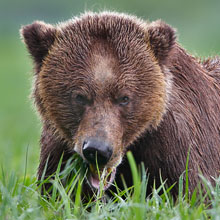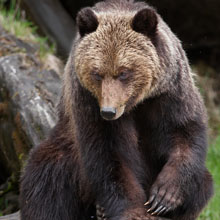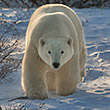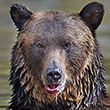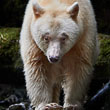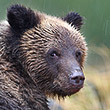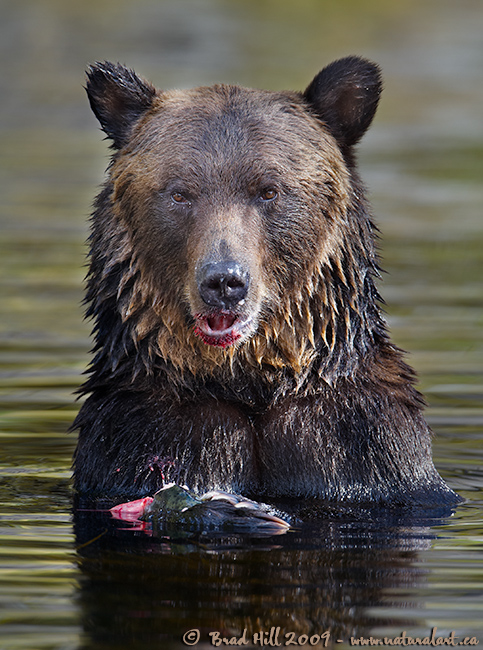
Availability: Undetermined - Enquiries?
In the Field
Wanna Share My Salmon? Northern BC Coast (Great Bear Rainforest), BC. October 2, 2009.
This female grizzly bear is a young mother with a cub and one of the most attractive grizzlies I have ever seen or photographed. Like her cub she has a very dark face that sets her rusty brown eyes off just so well! I shot this portrait of her as she sat in the shallow water of an estuary in the Great Bear Rainforest. She very kindly cleaned herself up (by dunking her head in the water) just before I shot this image, but it would appear that her skill at applying lipstick still needs some work (I believe she uses the "Salmon Blood" colour from Faberge). But it wasn't just her good looks that motivated me to shoot this image - it was the absolutely trusting look on her face that won me over - to me she looked like she almost wanted to share that salmon cradled in her claws! I know that female grizzlies with cubs have a reputation of being both fearsome and highly dangerous (and her cub was just out of the frame of this image) - but I guess this proud mother hadn't read the book on how ferocious she was supposed to be...
What makes this image work reasonably well for me (besides the attractiveness of the bear and my memory of the encounter) is the detail. Unfortunately, when an image is reduced down in size for web presentation the fine detail is often lost - here's a larger version (1200 pixels) where more of (but not all) the fine detail is shown.
A few technical comments on this image. First, when working up close with wildlife while using medium to long telephoto lenses it's real important to keep your depth of field AND focus point in mind. I often like using a shallow depth of field to isolate my subject from the background, but the risk in doing this is that critical portions of your subject will be outside your zone of sharpest focus. So...it's critical to know how much depth of field you have in FRONT of your focal point and BEHIND your focal point (and to position your focus point just right). Many books and online guides state that depth of field is distributed with 1/3 in front of the focus point and 2/3 behind. While this is close to true with short focal length lenses (like wide angles), it's simply wrong with lenses at 200 mm and above. With virtually ALL telephoto lenses you have 50% of your depth of field in front of your focus point and 50% of it behind your focus point (at all apertures). Here, I focused about 2/3 the way up the snout (but still in FRONT of the eyes) to ensure that both the snout/mouth region AND the eyes were in focus. Oh...and by the way - the nose isn't out of focus, it's just covered with gooey salmon slime that looks pretty much like vaseline!
Second, when processing images of animals with wet fur - go very easy on the sharpening (both during raw conversion and when prepping the image for output) as wet fur acquires that "over-sharpened" look really fast. In this image there has been NO sharpening applied to the region of the bear near the water or on most of it's face (I did very finely sharpen the eyes and the hairs just above the forehead).
This image was captured during my annual "Spirit Bears and the Great Bear Rainforest" Instructional Photo Tour in the autumn of 2009. If you're interested in joining me on one of my photo tours into the Great Bear Rainforest, check out the details on my "Photo Tours" page. My Instructional Photo Tours into the Great Bear Rainforest are run in conjunction with Ocean Light II Adventures - they offer a number of amazing adventure tours (including top-notch bear-viewing tours as well as tours of exploration of the Queen Charlotte Islands) and I highly recommend them!
Behind the Camera
Wanna Share My Salmon? Northern BC Coast (Great Bear Rainforest), BC. October 2, 2009.
Digital Capture; Compressed RAW (NEF) 14-bit format; ISO 200.
Nikon D3 with Nikkor 600 mm f/4G ED-IF AF-S VR lens - handheld from floating Zodiac. VR on and set to "Normal" mode.
1/250s @ f5; -0.3 stop compensation from matrix-metered exposure setting of camera.
At the Computer
Wanna Share My Salmon? Northern BC Coast (Great Bear Rainforest), BC. October 2, 2009.
RAW Conversion to 16-bit TIFF, including first-pass/capture sharpening using Phase One's Capture One Pro 4.8. Three RAW conversions at different exposure settings. Exposure settings of -0.5 stops (for background and to retrieve highlights) through to +1.0 stops (to retrieve shadow detail on left side of bear's face).
Further digital corrections on 16-bit TIFF file using Adobe's Photoshop CS4. Photoshop adjustments included compositing and masking of 3 exposure versions, selective saturation and desaturation, and selective sharpening for web output.
Conservation
Wanna Share My Salmon? Northern BC Coast (Great Bear Rainforest), BC. October 2, 2009.
Ten percent of the revenue generated by this image will be donated to Raincoast*.
Species Status in Canada**: Special Concern (May 2002).
While Grizzly Bears (Ursus arctos) are not technically listed as "Endangered" in Canada, they have been extirpated from most of their historical range. Grizzly Bears are far more sensitive to intrusion/disturbance in their habitat than are Black Bears and are being increasingly forced into marginal habitat by human encroachment. The Great Bear Rainforest along the central and northern coast of British Columbia is one of the last strongholds of the Grizzly Bear in Canada, and even this population is coming under increasing pressure.
On December 18, 2017 the government of British Columbia banned grizzly hunting across the entire province. This major conservation victory came after decades of tireless work by many dedicated conservationists and ecologists and, most importantly, it reflects the opinion of the vast majority of British Columbians. And, it means that AT LEAST while the current government remains in power grizzlies are finally "safe" in British Columbia.
Now that we've at least temporarily won the battle to save grizzlies in BC, it's time to re-focus our efforts toward protecting ALL of BC's carnivores, including Gray Wolves, Black Bears, Cougars, Wolverines, and more! Simply put, there are no ecological, economic, or ethical arguments supporting the trophy hunting of carnivores.
In a great first step towards ending the hunting of carnivores throughout BC the Raincoast Conservation Foundation has developed a program designed to protect ALL carnivores within the Great Bear Rainforest. Details about this program can be found on this page on Raincoast's website. Check it out and, better yet, make a donation to help Raincoast purchase the remaining commercial hunting tenures in the Great Bear!
*The Raincoast Conservation Society (and Foundation) is an effective and efficient organization that has been fighting for protection of this unique habitat. If you are looking for a meaningful way to contribute to the conservation of this amazing ecosystem, Raincoast will provide maximal "bang" for your conservation dollars.
**as determined by COSEWIC: The Committee on the Status of Endangered Wildlife in Canada


















